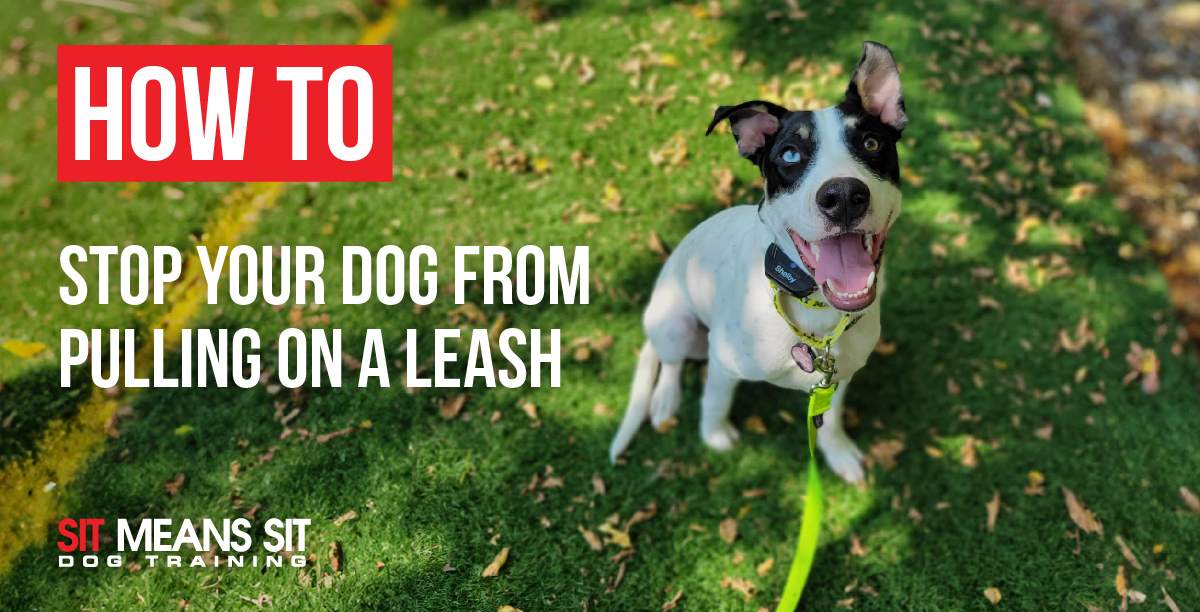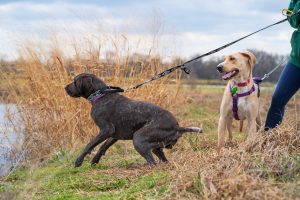
How to Stop Your Dog From Pulling on a Leash
As dog trainers, we’ve seen many owners come in frustrated with their dog’s leash pulling behaviors. Walking your dog is a great way to get their (and your) energy out as well as to provide mental stimulation, especially if they are by themselves during your work day.
However, constant leash pulling can easily put a strain on your relationship with your dog. It can be a stressful, exhausting, unpleasant and unsafe experience for the both of you.
One thing to note about dog training is that there is no one-size-fits-all method. Different dogs respond to different training methods, so patience will be key on your journey. Closely observe what motivates your dog, and stay consistent with your training.
Ways to Stop Dogs Pulling On Leash
So, how do you walk a dog that pulls on their leash? You can start with the following small, easy changes.
1. Use the Right Equipment
Train with the right tools at your disposal! We recommend using a 6-foot leash for training. Compared to a retractable leash, you’ll have more control over your dog’s pulling, while also allowing them the space to learn and explore.
We’ve often also recommended using a Martingale collar for training. Martingale collars are designed to tighten around your dog’s neck if they pull, but not so tight that it harms or chokes them. The collar automatically loosens once they stop pulling. This trains your dog to associate the tightness with pulling.
2. Exercise Your Dog Before Your Walk
It may seem counterintuitive as the walk is meant to be the exercise, but exercising your dog before their walk is a good way to get their energy out. Play fetch or tug-of-war with them before leaving on your walk. Maybe give them an additional mental workout by giving them a toy that’s hiding a treat. By doing this, you can reduce leash pulling by expending some of their excess physical and mental energy.
3. Unlearning Leash Pulling Movements
Dogs learn that when they pull on their leash, they can get to something they want. The trick here is to disrupt the pulling and to reinforce the behavior that you do want. Stop in your tracks and stay still. As soon as they give the leash some slack, reward them with a treat. You will likely have to do this often and consistently at first. Another way would be to turn the opposite direction of where they are pulling, which puts them right behind you, and disrupts the behavior.
4. Use Positive Reinforcement
Pay attention to what treats your dog enjoys and values, and use those to reward them when they’re not pulling on their leash. This should be something that they don’t often get as a special treat.
Steps to Train Your Dog Not to Pull On a Leash
Now that we’ve covered ways in which you can get your dog to stop pulling on their leash, the next step is to understand how you can train the behavior out of them.
1. Find a Controlled Environment
Locate a quiet, controlled area to begin your leash training. This spot should be free of visual and auditory distractions. You want your dog focused completely on you and what you’re saying/doing.
2. Stand Still and Let Them Explore
While on the leash, let your dog explore the area through the length of their leash. If they start pulling away, turn the opposite direction. If they come towards you, reward them with a treat or loud praise. Instead of using the verbal cue “no,” refrain from using any verbal cues or reprimands at this stage. The non-verbal cues should still encourage your dog to continue to come back to you and walk by your side.
3. Incorporate Turns
Once your dog starts learning that walking beside you gets a reward, start incorporating turns, changes in walking speed, and direction changes. Use your body language and gently tug on the leash in the direction you want to go and let them learn that by following you, they get rewarded.
4. Add Distractions
As your dog’s leash pulling improves, start introducing more distractions, like taking them to a dog park or walking them around the neighborhood where other dogs might be present. Reinforce good behavior, and continue to use the previous training steps as well. You may have to go back to the controlled environment training and continue practicing without distractions if they don’t initially do well at this stage.
5. Remain Consistent
Practice training commands with your dog regularly, from everyone in your household. Be patient if they revert back to old behaviors. By staying consistent and using positive reinforcement, you’re slowly teaching them about what makes for good leash behavior which will engrain the new habit in their day-to-day.
Experienced Dog Trainers for Leash Pulling
You are not alone! We know that leash pulling behavior can be complex and difficult to manage. It will take time and effort, but we’ve helped many dog owners curb or eliminate leash pulling with some patience and proper training help. Do not be discouraged if the process takes several months. Your furry friends are adjusting to and learning new behaviors after all! Our dog trainers at Sit Means Sit are experienced in teaching owners and dogs how to manage or eliminate leash pulling.
Call us today to get your free evaluation.


